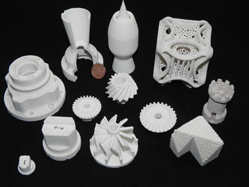Crossref Citations
This article has been cited by the following publications. This list is generated based on data provided by
Crossref.
Niu, Fangyong
Wu, Dongjiang
Ma, Guangyi
and
Zhang, Bi
2015.
Additive manufacturing of ceramic structures by laser engineered net shaping.
Chinese Journal of Mechanical Engineering,
Vol. 28,
Issue. 6,
p.
1117.
Zocca, Andrea
Colombo, Paolo
Gomes, Cynthia M.
Günster, Jens
and
Green, D. J.
2015.
Additive Manufacturing of Ceramics: Issues, Potentialities, and Opportunities.
Journal of the American Ceramic Society,
Vol. 98,
Issue. 7,
p.
1983.
Niu, Fangyong
Wu, Dongjiang
Ma, Guangyi
Wang, Jiangtian
Zhuang, Juan
and
Jin, Zhuji
2016.
Rapid Fabrication of Eutectic Ceramic Structures by Laser Engineered Net Shaping.
Procedia CIRP,
Vol. 42,
Issue. ,
p.
91.
Ferrage, L.
Bertrand, G.
Lenormand, P.
Grossin, D.
and
Ben-Nissan, B.
2017.
A review of the additive manufacturing (3DP) of bioceramics: alumina, zirconia (PSZ) and hydroxyapatite.
Journal of the Australian Ceramic Society,
Vol. 53,
Issue. 1,
p.
11.
Chang, Shuai
Li, Liqun
Lu, Li
and
Fuh, Jerry
2017.
Selective Laser Sintering of Porous Silica Enabled by Carbon Additive.
Materials,
Vol. 10,
Issue. 11,
p.
1313.
Wang, Dianzheng
Yu, Chenfan
Ma, Jing
Liu, Wei
and
Shen, Zhijian
2017.
Densification and crack suppression in selective laser melting of pure molybdenum.
Materials & Design,
Vol. 129,
Issue. ,
p.
44.
Li, Yuzhou
Hu, Yingbin
Cong, Weilong
Zhi, Lin
and
Guo, Zhongning
2017.
Additive manufacturing of alumina using laser engineered net shaping: Effects of deposition variables.
Ceramics International,
Vol. 43,
Issue. 10,
p.
7768.
Zhang, Geng
Chen, Hua
and
Zhou, Hongwei
2017.
Additive manufacturing of green ceramic by selective laser gasifying of frozen slurry.
Journal of the European Ceramic Society,
Vol. 37,
Issue. 7,
p.
2679.
DeVries, Matthew
Subhash, Ghatu
Mcghee, Alexander
Ifju, Peter
Jones, Tyrone
Zheng, James
and
Halls, Virginia
2018.
Quasi-static and dynamic response of 3D-printed alumina.
Journal of the European Ceramic Society,
Vol. 38,
Issue. 9,
p.
3305.
Moniz, Liliana
Colin, Christophe
Bartout, Jean-Dominique
Terki, Karim
and
Berger, Marie-Hélène
2018.
Laser Beam Melting of Alumina: Effect of Absorber Additions.
JOM,
Vol. 70,
Issue. 3,
p.
328.
Chen, An-Nan
Li, Meng
Xu, Jie
Lou, Chen-Hua
Wu, Jia-Min
Cheng, Li-Jin
Shi, Yu-Sheng
and
Li, Chen-Hui
2018.
High-porosity mullite ceramic foams prepared by selective laser sintering using fly ash hollow spheres as raw materials.
Journal of the European Ceramic Society,
Vol. 38,
Issue. 13,
p.
4553.
Danezan, A.
Delaizir, G.
Tessier-Doyen, N.
Gasgnier, G.
Gaillard, J.M.
Duport, P.
and
Nait-Ali, B.
2018.
Selective laser sintering of porcelain.
Journal of the European Ceramic Society,
Vol. 38,
Issue. 2,
p.
769.
Xing, Zhanwen
Liu, Weiwei
Chen, Yao
and
Li, Wenli
2018.
Effect of plasticizer on the fabrication and properties of alumina ceramic by stereolithography-based additive manufacturing.
Ceramics International,
Vol. 44,
Issue. 16,
p.
19939.
Zhang, Haidong
and
LeBlanc, Saniya
2018.
Additive Manufacturing of High-performance Metals and Alloys - Modeling and Optimization.
Chen, An-Nan
Wu, Jia-Min
Liu, Kai
Chen, Jing-Yan
Xiao, Huan
Chen, Peng
Li, Chen-Hui
and
Shi, Yu-Sheng
2018.
High-performance ceramic parts with complex shape prepared by selective laser sintering: a review.
Advances in Applied Ceramics,
Vol. 117,
Issue. 2,
p.
100.
Fan, Zhiqi
Lu, Mingyuan
and
Huang, Han
2018.
Selective laser melting of alumina: A single track study.
Ceramics International,
Vol. 44,
Issue. 8,
p.
9484.
Ferrage, Loïc
Bertrand, Ghislaine
and
Lenormand, Pascal
2018.
Dense yttria-stabilized zirconia obtained by direct selective laser sintering.
Additive Manufacturing,
Vol. 21,
Issue. ,
p.
472.
Bai, Yu-chao
Fu, Fan
Xiao, Ze-feng
Zhang, Ming-kang
Wang, Di
Yang, Yong-qiang
and
Song, Chang-hui
2018.
Progress in selective laser melting equipment, related biomedical metallic materials and applications.
Journal of Zhejiang University-SCIENCE A,
Vol. 19,
Issue. 2,
p.
122.
Wei, Chao
Chueh, Yuan-Hui
Zhang, Xiaoji
Huang, Yihe
Chen, Qian
and
Li, Lin
2019.
Easy-To-Remove Composite Support Material and Procedure in Additive Manufacturing of Metallic Components Using Multiple Material Laser-Based Powder Bed Fusion.
Journal of Manufacturing Science and Engineering,
Vol. 141,
Issue. 7,
Florio, Kevin
Pfeiffer, Stefan
Makowska, Malgorzata
Casati, Nicola
Verga, Fabrizio
Graule, Thomas
Van Swygenhoven, Helena
and
Wegener, Konrad
2019.
An Innovative Selective Laser Melting Process for Hematite‐Doped Aluminum Oxide.
Advanced Engineering Materials,
Vol. 21,
Issue. 6,



